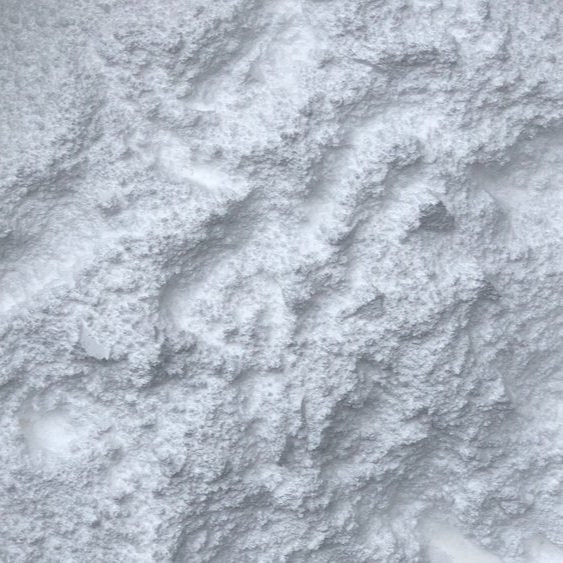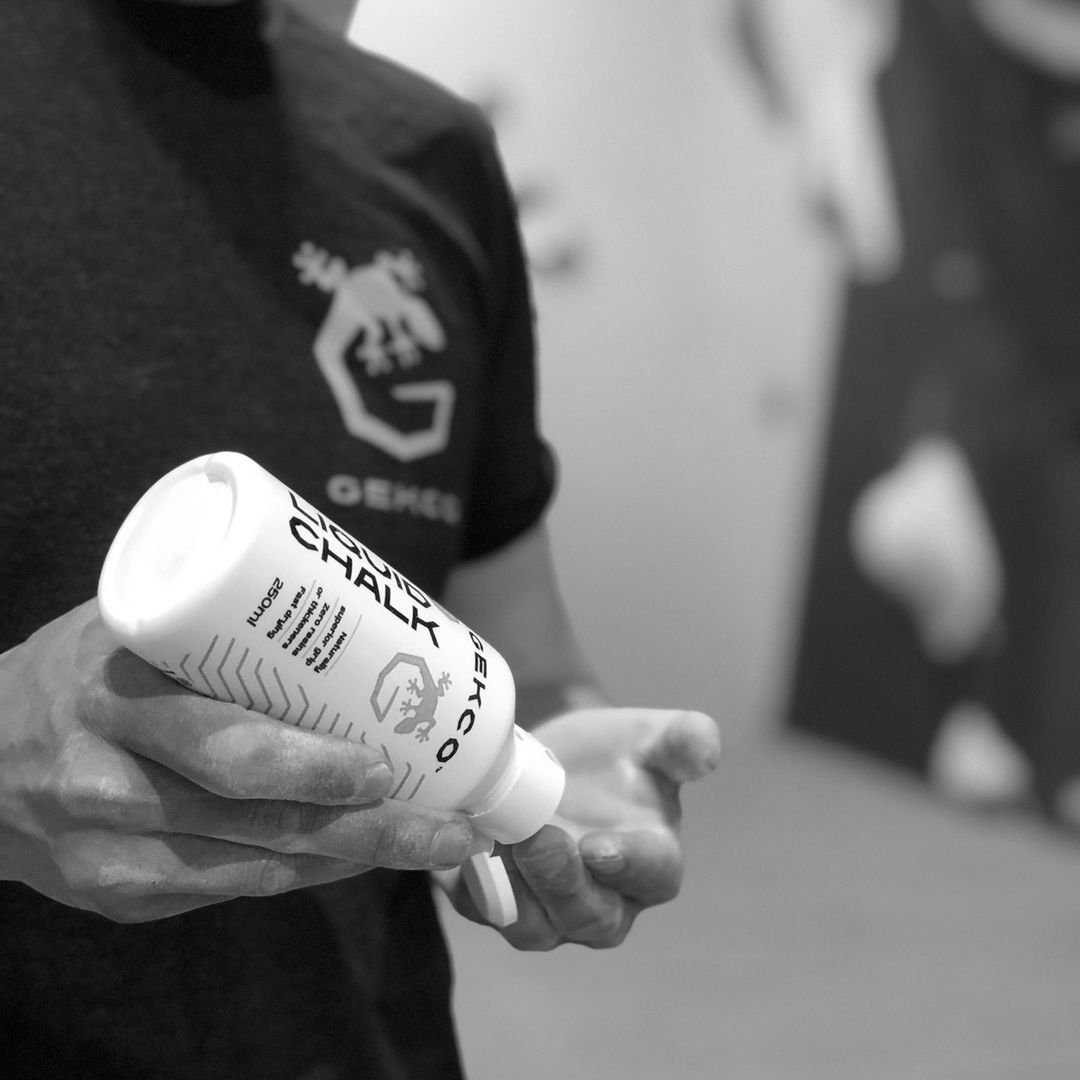Use less chalk
Alongside climbing shoes, chalk has become an essential for almost every climber. The process of throwing your hands into your chalk bag and coating every centimetre of skin has become an unconscious habit. But does more chalk mean more friction?
There are limited studies investigating the effect of using chalk on our climbing and those that do exist give conflicting conclusions. A study conducted in 2010 found that the particles of chalk actually made the surface more slippery as it creates a granular layer between the hand and the hold. Contradictory to this, a later study in 2012 tested 11 experienced climbers with a specially made hang board and found it enhanced participants' grip and had a positive effect on coefficient of friction. In 2016, a study of 19 climbers concluded that they were able to hang longer with chalk, but found no significant difference in coefficient of friction. Of course, the different methods employed by these studies produce a variation in results.
The take away from this, is that chalk itself is not a material that makes your hands more grippy, but it does remove sweat. By taking sweat out of the equation, we improve our grip which is essential when you're clinging onto the crux of your project. Everyone’s hands react differently when climbing, while a lucky few have naturally very dry hands and others will sweat a lot more, making it more difficult for them to grip holds. Some may need a lot of chalk, while some not so much… As well as this, it can help prevent minor skin injuries, like ‘flappers’ which are more likely to occur when skin is moist. Chalk is beneficial for most climbers, but does not directly increase friction, instead it removes sweat from the equation. So the key point here is that increasing the chalk on your hands won’t increase the friction of your grip, you just need a layer to absorb the sweat. In fact, if you are to consider the study from 2010, more chalk could potentially be increasing slippage by creating a granular layer between the hold and your hand.
Ethical Implications
From what we have found, chalk was first used in climbing in 1954, when a man named John Gill, now dubbed the ‘father of modern bouldering’, recognised its properties when practising gymnastics. He found it was particularly useful in helping him send some impressive dynos and introduced it to his other climbing friends. Before long, chalk was being used by the majority of climbers worldwide. Yet some purists argue that the use of chalk undermines Leave No Trace ethics of climbing and shouldn’t be used at all! Prior to this, climbers would just wipe their hands on their trousers or rub in a handful of dirt. Some areas have even banned the use of chalk entirely in order to keep the rock clean, including Garden of the Gods in Colorado, Arches National Park in Utah and several areas across the Czech Republic. It is unsurprising that some areas have decided to enforce this, as chalk on certain porous or overhanging rock may not wash off with rain like it might elsewhere. Some may even consider this similar to vandalism or graffiti! Of course, as climbers, this is the last thing we intend to do, and so we must all be conscientious of how we use chalk and that we make an effort to remove any that we have left behind.
Issues of Sourcing
Not only has chalk caused debate amongst the climbing community, it’s methods of sourcing also come with various environmental impacts and risks to sustainability. 70% of magnesium products are exported from Liaoning Province, China, where open pit mines and low-technology cause enormous dust pollution and have resulted in severe degradation of soil, water and air quality. The air pollution in Liaoning fluctuates between unhealthy and hazardous, meaning the population will experience an increase in health problems. Other methods of sourcing also carry their own problems, such as depletion and resulting degradation. It’s simple, the more we use a resource, the faster it becomes depleted and degraded. As climbers, we can avoid purchasing chalk that is sourced in a way that causes damage, and instead research brands that provide an ethically sourced product.
Air Quality
The use of chalk impacts the air quality at your local gym. Speaking from experience of working at a climbing wall long-term, the chalk created a noticeable haze in the building. After a shift, I would blow my nose to find a grey/black mess in the tissue, and that’s the dust that was stopped from being breathed in, so I can only imagine what the inside of my lungs looked like! But hey, don’t take my word for it. In 2020, researchers from Old Dominion University investigated the health implications of climbing chalk dust, and found dangerously unhealthy levels of particulate matter at the Appalachian State University wall. One way of combating this problem is investing in filter fans to remove the particles from the air, something the wall I was working at did, and proved to be very effective. Another way is to use less chalk, or make the switch to chalk balls or liquid chalk.
Impact on Rock Dwelling Flora
A study conducted in 2020 suggests climbing chalk also has a lasting impact on rock dwelling organisms. Researchers discovered elevated levels of climbing chalk in areas where it was not visible, and found that this negatively impacted germination and survival of flora species. This study argued that it is likely the changes in pH from the presence of magnesium carbonate, is the cause of this.
So where does that leave us...?
Much controversy remains around the issue of chalk, just check out one of the many forums such as UKC for some heated debates on the subject! Clearly, there are significant risks surrounding the sourcing and use of climbing chalk. But while some purists argue chalk should be banned, let’s be honest, chalk is probably here to stay! The research suggests that chalk improves our friction, and even from our own experience, we know this to be true. So as we continue to use chalk as conscientious climbers, should we not consider what impact we are having and how we can limit that?
In order to do our part in limiting environmental issues and conforming to Leave No Trace ethics, as climbers we can simply use less chalk and closely consider what products we purchase. Here are the ways you can do it:
Don’t unnecessarily chalk up
For many, chalking up has become a ritualist habit that plays a part in the mental game of climbing. I often find myself shoving my hands in my chalk bag and coating my skin, even if I’m not about to climb anything. This might be one of the most difficult changes to make as it has become an unconscious practice, however, it could make a huge difference. Imagine how much less chalk would be used if we all chalked up just the once before a boulder route, rather than several times before - and after!
Use resin-free liquid chalk
Liquid chalk hugely reduces chalk waste and improves the air quality of climbing gyms. Gekco Liquid Chalk is made with alcohol and magnesium carbonate alone, without the use of resins or thickeners. Resins cause a slippery, glassy build up on holds, achieving the opposite of the desired effect of creating friction. If you choose to use liquid chalk as an alternative, avoid any that contain resin for this reason. Check out our ‘Resin Build Up’ blog for more on this.
Purchase ethically sourced chalk products
Considering the environmental impacts of mining operations in China, it is best to search for brands that produce ethically sourced chalk. One way of doing this is by visiting company websites and searching for brands that are transparent about their efforts towards sustainability. If it’s something a brand values, it’s likely they will be sourcing materials in the most ethical way they can i.e avoiding Chinese magnesium carbonate.
Balls
Chalk balls are a great way to limit the amount of chalk that’s dispensed to your hands. It’ll help you use less chalk, while also preventing large dust clouds that impact the air quality of your gym. When buying a chalk ball, consider the packaging and the materials used, and how these may have an environmental impact. Gekco Chalk Balls are made with sustainably grown hemp, which also means they are fully biodegradable!
Avoid or make sure you brush off tick marking
A tick mark is a line of chalk drawn on the rock, used to help the climber find a hold that is otherwise difficult to spot while on the route. This can be helpful for specific routes, but shouldn’t really be common practice to reduce the markings on the rock and limit environmental impact. Leaving these marks can also affect the experience of future climbers in their route reading, taking away the excitement of working out the problem. If a tick mark is necessary, ensure you take a decent brush with you so that it can be removed after you have finished climbing the route.
Brush your holds
The chalk from your hands transfers to the rock when climbing, leaving behind the white marks we see scattered across crags. It goes further than the visual impact though, a hold caked with chalk will actually hold more moisture when it gets some of our lovely British wet stuff. This can make the rock slippery on arrival and lead to you using more chalk than usual. To avoid these build ups, we could each brush off holds that are possible to reach, leaving the rocks as we found them, or even better.





